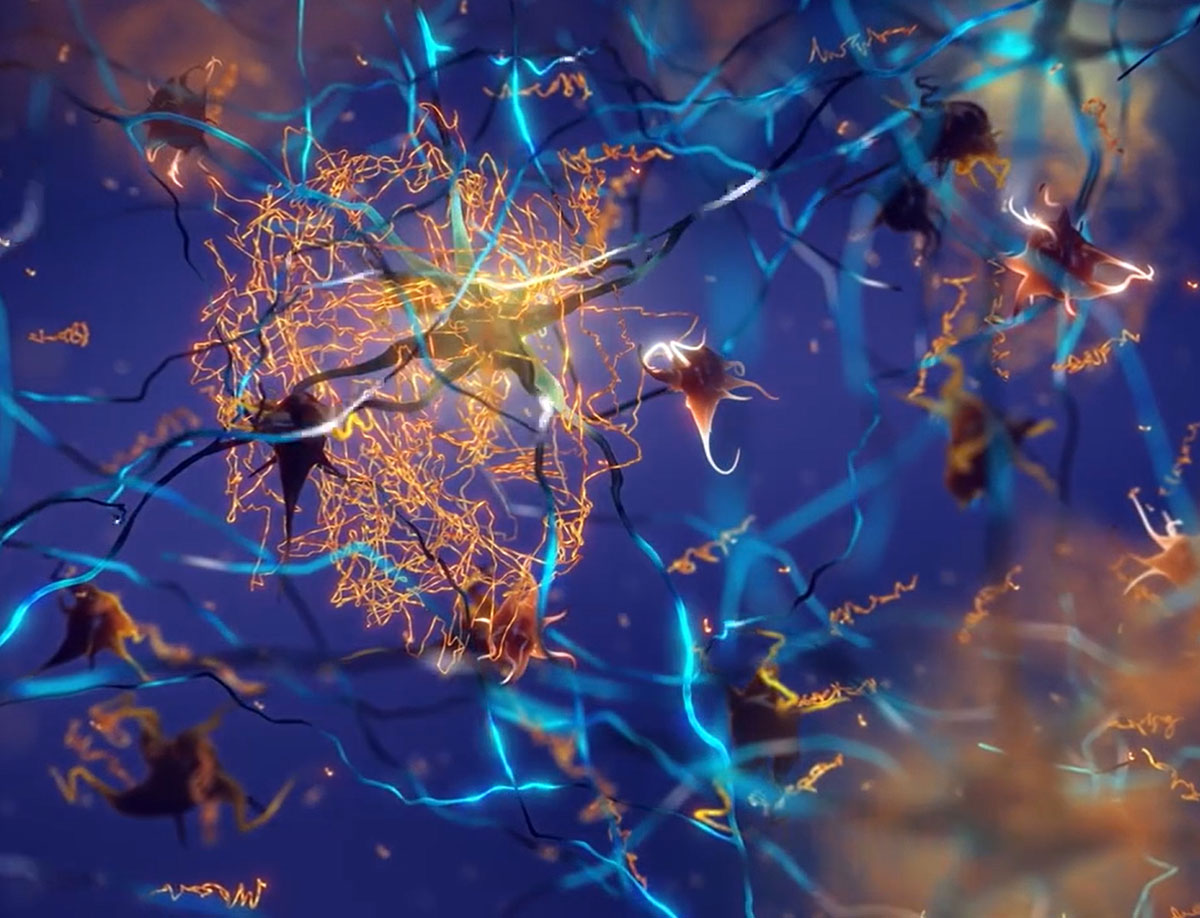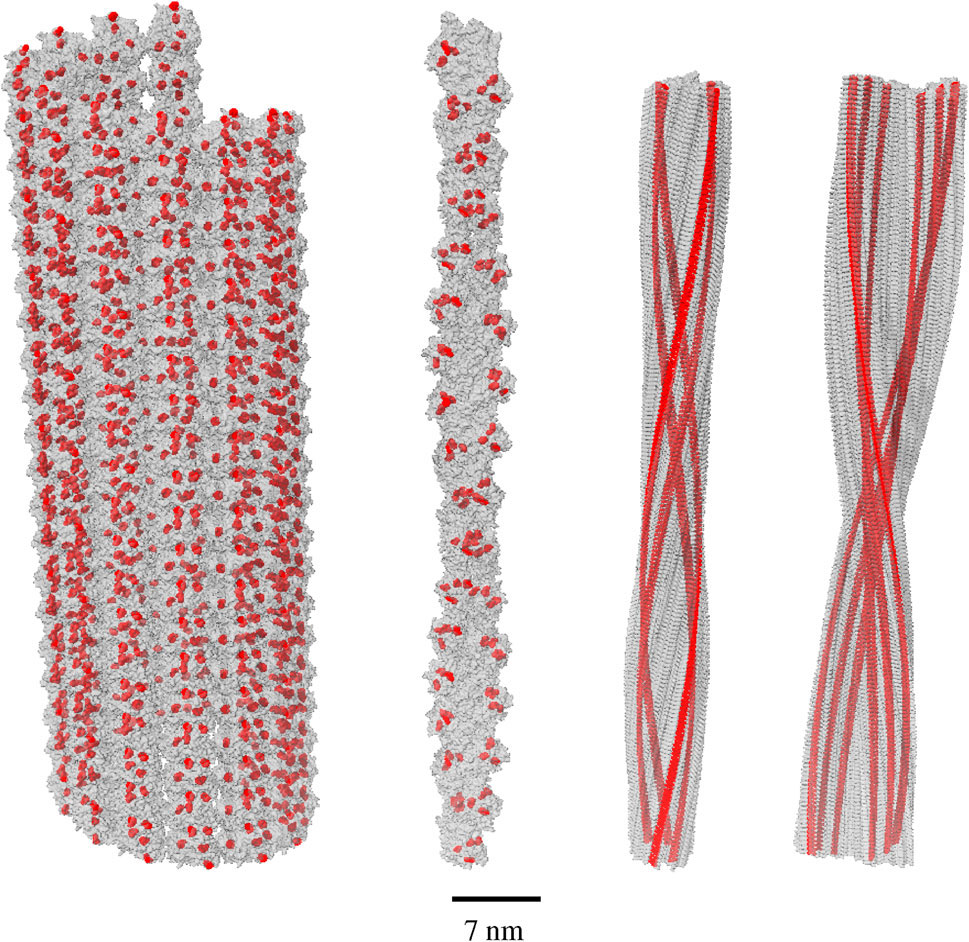An artist’s interpretation of amyloid fibrils clumping around a nerve cell. New quantum-optical research from scientists at Howard University suggests that such fibrils, long considered a key pathology and treatment target for Alzheimer’s disease, might actually have a neuroprotective effect. [Image: Quantum Biology Laboratory: Nathan Babcock and Philip Kurian / Howard University]
In recent years, a small community of researchers has highlighted the possible role of quantum effects in biology, in phenomena ranging from photosynthesis to the sense of smell to the migration of birds. A numerical study of quantum optics in a biological system now casts a potentially startling light on another arena: the understanding and treatment of Alzheimer’s disease.
A research team led by Philip Kurian at Howard University, USA, has dug into the quantum phenomenon of superradiance in tryptophan, a strongly fluorescent amino-acid molecule found in several biologically important elongated structures—including the amyloid fibrils characteristic of Alzhemier’s disease (Front. Phys., doi: 10.3389/fphy.2024.1387271). The team’s modeling suggests that these elongated architectures lead to a striking enhancement of tryptophan supperradiance. And that, in turn, means a significant boost in the molecule’s ability to absorb potentially damaging UV photons and down-convert them to more benign, longer wavelengths.
Kurian and his team think the modeling results should prompt a dramatic change in thinking about the role of amyloid fibrils in Alzheimer’s. Commonly, so-called amyloid plaques are viewed as one of the neurodegenerative ravages of the disease, and thus as a target for treatment. Instead, the researchers argue, amyloid fibrils could actually be a protective response by the body—shielding neurons against potential damage from UV photons thrown off by metabolic processes in the chemically stressed Alzheimer’s brain.
Clumps, plaques and tangles
Amyloid fibrils are helical collections of proteins called beta-amyloids. In some circumstances, these fibrils aggregate into clumps to form amyloid plaques, which are a hallmark of Alzheimer’s disease and some other neurodegenerative disorders.
Kurian and his team think the modeling results should prompt a dramatic change in thinking about the role of amyloid fibrils in Alzheimer’s.
The conventional view is that these plaques play a big part in the development of the dementia associated with Alzheimer’s disease, by triggering inflammation, damaging neurons, disrupting brain communication and causing the production of another baleful feature, abnormal tangles of so-called tau proteins. As a result, finding drugs that can reduce the quantity of amyloid plaques, or keep them from forming in the first place, has been a key focus of Alzheimer’s treatment research.
But there’s a problem with this picture. Some studies suggest that as many of 30% of people who have “Alzheimer’s brains” rife with amyloid plaques and tau tangles don’t develop symptoms of dementia. And while a number of treatments targeting amyloid plaques have been approved, they have proved far from a magic bullet against Alzheimer’s dementia.
Oxidative stress and UV photons
Another side of dementia that has attracted increasing interest is the role of oxidative stress, which arises from free-radical molecules in the diseased brain. Free radicals are highly reactive chemical species that contain one or more unpaired electrons in their outer shells, and can do violence by reacting with and altering lipids, proteins, nucleic acids and other biomolecules. They have been implicated as a potential agent of disaster not only in neurodegenerative diseases but in a variety of other disorders as well.
Interestingly, these reactive molecules have a number of connections with UV photons. UV light, for example, is known to have a role in creating some reactive species through interactions with oxygen molecules. And free-radical molecules themselves can churn out UV photons (as well as photons at other wavelengths) through metabolic processes.
One such process is ultraweak photon emission (UPE), which occurs when metabolically excited electron states in various reactive species relax to the singlet ground state—pumping out photons at various wavelengths in the process. In environments of high oxidative stress, such photon emissions can start to become noticeable. It’s even been proposed that measuring UPE could constitute a tool for monitoring the progression of Alzheimer’s and other neurodegenerative diseases.
Studying superradiance in tryptophan

Philip Kurian. [Image: Howard University]
Could these metabolic photon emissions from free-radical species—in an environment rife with oxidative stress, such as the Alzheimer’s brain—actually have a role in the disease? The question began to intrigue Kurian, the leader of the new research, when he worked as a postdoc in partnership with the group of Thomas Obisesan, a geriatrician in the Howard University College of Medicine.
“We had many discussions about the role of metabolic photon emissions and oxidative stress in the progression of Alzheimer’s,” Kurian told OPN in an email. As a result, he said, he “began examining anomalous protein aggregates that are hallmarks of many neurodegenerative pathologies, including amyloid fibrils, from an open-quantum-systems perspective.”
One such study, published earlier this year, looked at the phenomenon of superradiance—the absorption or emission of photons at substantially higher-than-expected rates, owing to quantum effects—in molecules of tryptophan, as laid out in the long, thin cellular structures known as microtubules. Tryptophan is a strongly fluorescent, UV-absorbing amino acid present in many proteins. Interestingly, tryptophan also shows a large absorption–emission Stokes shift—meaning it significantly down-converts the wavelength of absorbed photons, re-emitting at longer, lower-energy wavelengths.
In the microtubule study, the team numerically predicted that complex tryptophan networks arranged in microtubule structures would show significant enhancement in superradiance—with the enhancement effect increasing with greater microtubule length. And they confirmed the numerical result experimentally through measurements of quantum yield in various structures.
The amyloid fibril difference
The Howard University team modeled the quantum superradiance of networks of the fluorescent amino acid tryptophan in several important bioarchitectures, including microtubules (far left), actin filaments (second from left) and amyloid fibrils (second from right and far right). [Image: H. Patwa et al., Front. Phys. 12, 1387271 (2024), doi: 10.3389/fphy.2024.1387271; CC-BY 4.0]
In the new study, Kurian’s team has expanded its view to a number of other filament-like bioarchitectures containing networks of tryptophan molecules, including not only microtubules but also actin filaments and amyloid fibrils.
The researchers first developed simple physical “toy” models for the biostructures, and inferred the Hamiltonian—the mathematical matrix description of the energy state—for each model. They then numerically extracted the complex eigenvalues, or characteristic values, of the energy matrix for microtubule, actin and amyloid structures of differing lengths. Finally, they used those values to calculate the expected superradiant enhancement of the thermal quantum yield (the ratio of the number of photons emitted to the number absorbed, at thermal equilibrium).
The team found what Kurian, in a press release accompanying the work, called an “enormous” predicted superradiant enhancement for tryptophan molecules when they were embedded as networks in amyloid fibrils—up to five times the quantum yield of an individual tryptophan molecule. In an email to OPN, Kurian said this was due mainly to two features: the “extremely high density” of tryptophan in fibrils, which leads to stronger electromagnetic coupling; and the helical symmetry of the fibril architecture.
The Alzheimer’s connection
Kurian and his team believe their study has profound implications for how the Alzheimer’s community should view the role of amyloid proteins.
In an environment of severe oxidative stress such as the Alzheimer’s brain, the researchers suggest, the abundance of metabolically produced free-radical species could result in increased photon emissions across the spectrum—including potentially damaging shorter-wavelength, higher-energy UV photons. Viewed in this light, the highly superradiant tryptophan molecules in amyloid fibrils would be extremely efficient at sopping up those dangerous UV photons in the immediate environment and re-emitting their energy in a less harmful form. “Our work shows that amyloid fibrils can actually provide an enormous neuroprotective response due to this quantum-optical effect,” Kurian told OPN, “by absorbing high-energy UV photons rapidly and down-converting them to longer, safer wavelengths.”
“Our work shows that amyloid fibrils can actually provide an enormous neuroprotective response due to this quantum-optical effect,” Kurian told OPN, “by absorbing high-energy UV photons rapidly and down-converting them to longer, safer wavelengths.”
In terms of Alzheimer’s treatments, Kurian suggested that new directions will depend critically “on researchers rejecting the amyloid cascade hypothesis, on which many modern Alzheimer’s drugs are based.” He said his team’s work might conceivably point to some novel alternative ideas, such as using nanoparticles to deliver additional UV superabsorbers to help out. But the best approach, he noted, may well be to focus on addressing the underlying causes of oxidative stress, through measures such as “low-impact exercise, healthy diet, minimal stress, spiritual connection and strong community.”
Superradiance and neural computation
Looking beyond Alzheimer’s, the researchers write that their results also “pose opportunities for a paradigm shift in the theory of neuronal information processing and signaling.” In his communication with OPN, Kurian elaborated on this notion.
Kurian observed, for example, that the tryptophan superradiant states in microtubules that the group has studied, such as those that might be found in neuronal axons, have lifetimes on the order of hundreds of femtoseconds—a very short timeframe relative to other neural activity. “You can think of them like miniature pulsed lasers,” he said, “producing superradiant ‘bursts’ at the quantum level to modulate the neurochemical … spikings that occur on much longer (millisecond) timescales.”
Such bursts would, he maintained, “drastically increase the computational capacity estimates for the human brain, and also for all eukaryotic organisms in the history of life on this planet.” A future paper, he suggested, will flesh this idea out.


